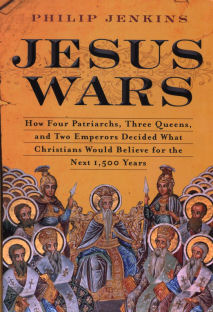
|
Posted April 12, 2010
Book: Jesus Wars: How Four Patriarchs, Three Queens, and Two Emperors Decided What Christians Would Believe for the Next 1,500 Years Author: Philip Jenkins Harper One. New York, New York. 2010. Pp. 317 An Excerpt from the Jacket:
Jesus Wars reveals how official, orthodox church teaching about Jesus was the product of political maneuvers by a handful of key characters in the fifth century. Jenkins argues that, were it not for these controversies, the papacy as we know it would never have come into existence and that today’s church could be teaching something very different about Jesus. An Excerpt from the Book: May those who divide Christ be divided with the sword, may they be hewn in pieces, may they be burned alive! Second Council of Ephesus, 449 In 449, the leading Fathers of the Christian church met in Ephesus, in Asia Minor, to debate pressing theological issues. At a critical moment, a band of monks and soldiers took control of the meeting hall, forcing bishops to sign a blank paper on which the winning side later filled in its own favored statement. The document targeted the patriarch of Constantinople, Flavian, one of the three or four greatest clerics in the Christian world. Yelling “Slaughter him!” a mob of monks attacked Flavian, beating him so badly that he died a few days later. So outrageous was the intimidation that the ultimate winners in the conflict invalidated this whole council. They repudiated it as a Latrocinium — loosely, a Gangster Synod. From later history, we know of many episodes when Christians would resort to violence, especially against members of other faiths, but in this instance, the different sides agreed on so much. Both factions accepted the same Scriptures and the same view of the church and hierarchy, and both agreed that Jesus Christ was God incarnate, the Second Person of the Holy Trinity. Where they disagreed so violently was over the nature of Christ. Flavian’s enemies, and their monkish militia, believed that Christ existed in a single nature in which the divine dominated. They felt by failing to proclaim this truth, by advocating a Christ in Two Natures, Flavian’s party had betrayed the core of Christianity. Literally, they thought, Flavian had divided Christ. From a modern point of view, we are baffled to see such extraordinary violence unleashed over what might appear to be a trivial philosophical row. Surely, we might think, these debates involved overfine distinctions quite as trivial as the proverbial disputes over the number of angels who could sit on the head of a pin. Just what could have caused such bitter hatred? In fact, the conflict involves a paradox that is quite central to the Christian faith. Christians must believe that God is wholly human and wholly divine, but it is easy for a believer to stray too far in one direction or the other. Either we might think of Christ purely as God, in which case he is no longer human, has no share in our human experience, and becomes a divinity in the sky like Zeus or Thor; or else, in contrast, we focus so much on his humanity that we underplay the divine element and deny the Incarnation. We would preach a Christ of two natures and two minds, literally a schizophrenic being. According to his enemies — unfairly and inaccurately — that was Flavian’s sin, and brutal violence was the only appropriate response to his gross insult to the Sone of God. Table of Contents: 1. The heart of the matter Part One: God and Caesar 2. The war of two natures 3. Four horsemen: the church’s patriarchs 4. Queens, generals and emperors Part Two: Council of Chaos 5. Not the mother of God? 6. The death of God 7. Chalcedon Part Three: A World to Lose 8. How the church lost half the world 9. What was saved |
|
